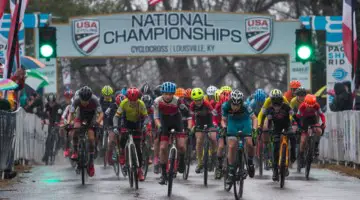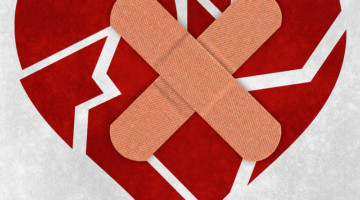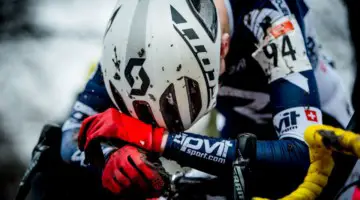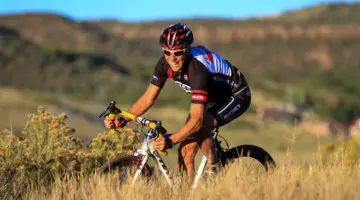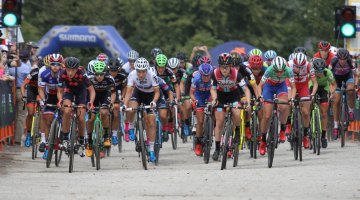Rad Racing’s junior star Eric Emsky returns with a new entry from Europe on his race day routine.
Everybody has their typical race day routine. The routine varies race to race, as some races need different preparation than others. Usually, we all place more time in preparing for a larger race for which more resources are dedicated rather than the smaller, local race.
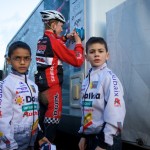
Eric Emsky treats race day like a pro, signs autographs for some young fans like a pro. Photo by Joe Sales
The race day routine here in Europe varies greatly race to race also. If a race is “far away,” we will wake up earlier than the usual 8 o’clock wake-up time to eat breakfast and pile into the race vans. When I say far, it isn’t a United States far. The farthest race we travel to be a maximum of two and a half hour drive being that Belgium is such a small country and all the races are relatively close. It’s entertaining to take a peek at a map of Belgium and recognize every other city because it holds an annual ‘cross race. Sans World Cup , Superprestige, and GVA races, the race day morning is quite relaxed as we wake up at our normal time, ready the race bag, and then head on out to the course. With the three races I just outlined, the start times are usually a bit earlier, starting from 10 to 11 in the morning.
Once we arrive at the course, if we have not picked up the numbers beforehand, we will make our way to a small, smoky bar with plenty of hefty UCI commissionaires and locals enjoying a cigarette or a brew. After emerging victoriously with numbers in hand and a slight head rush, the course pre-ride takes place. All the curious or unexpected sections are carefully examined, picked apart, analyzed again, and then bombed. Every single race has a weird little section to it. Somewhere in unspoken, written Belgian cyclocross code, such a section has to be included. No questions asked.
If we are lucky, there may be enough time between the 15-16 race and the Junior race to allow us to observe the nieuwelingens riding and racing the course and see how they are tackling a particular piece of the course. If there is not enough time to observe them, I would be on the stationary trainer warming up. Now there are three critical segments to a successful warm up. First of all, there is the wonderful feeling of first jumping on and warming up and spinning the legs out. Then comes along the dreaded “square legged” pedaling syndrome when your legs feel like you are spinning blocks. This is where the hard men strap up and get the job done. The last and the most important part of the warm-up are the openers. I like to approach the openers with a “can do!” attitude. They hurt, but if done properly you’ll arrive ready to go on that start line. The best trainer to get this job done doesn’t have too much resistance on it. That way you feel like Superman hearing it screaming in agony just like your competitors will a few short seconds later.
During our time on the trainer, all of the other preparations which need to be accomplished get done if you’re fortunate to have helpers. Chris de Vos is always handy to pin numbers and Els Dejonckheere can hook me up with a delicious rice tart or race cake. The race food is absolutely scrumptious! It’s one of my dirty little secrets, but the race food has to be one of the best parts about racing in Belgium.
Arriving on the start line, the tension can be cut with a quick swipe of your hand through the air. Sounds cheesy, but I just got that stereotypical nervous feeling in my chest as I write this. I guess I am hardwired to be a bike racer after all! The official calls the racers to the line. With every racer called to the line, the racers waiting to be called up get unbelievably nervous. It feels like the pack has already ridden away as you wait for your name to be called. Half the anxiety is relieved upon recognizing your name being called and you roll up to the line.
Like I said, only half the anxiety is relieved in rolling up to the line. The other half is waiting for the gun to go off. At this point in time, there are still usually a couple of minutes to spare. In this time the warm-up pants are removed as well as any other article of clothing not necessary for the race. Once this occurs, the smell of embrocating oil floods the air and burns the nostrils. The ever-present wind kicks up and in response, many racers start jumping in place. The clacking of toe spikes on the pavement should be the official sound of cyclocross, it sums the
The gun goes off and all the anxiety of let out in a furious rush. The start is vital. All too much I find myself in a bad spot making it really hard to get the holeshot. The holeshot is so critical because the fields are huge. Negotiating the field and moving up is stressful, one false move and its back to square one – dead last. You have to fight for everything. Everything!
Once you’re done surviving the first two laps, the next challenge is finding the magical groove. Go too hard and the inevitable blow will occur. Go too easy and the disappointment of crossing the finish line with something left in the tank will haunt you for life. The groove is something that is to be respected and finding it is a skill. The feeling of riding recklessly fast and in control is the best feeling in the world. Vroom vroom!
The final lap is the special lap designed to make you spelunk in the pain cave. By now, you either find yourself in a pack, or in between two riders. The time is now to do some hunting. The satisfaction of shutting down a gap between you and the rider in front of you feels so good. If you are able to do this, chances are you have also iced the cake by also blowing apart a huge gap between you and the rider chasing. For me, the pure epic-ness of fighting for a position at the line is just so pure, so essential to the sport of cyclocross. Pain is the name of the game.
Once the superman feeling of racing wears off after crossing the line. The wind chills the body and immediately the sweet help of the soigneur comes into play. Els will be waiting for me with my pair of warm-up pants and thermal jacket. It is so nice to have somebody on your side as soon as you cross the line. A cool down spin is next on the agenda and then it is to the heated van to change. The van is awesome. It’s an old Mercedes Sprinter van. It is fully-extended edition with one row of seats behind the driver’s seat and the rest is gutted and retrofitted with some wood benches and a big propane lamp. It’s a true godsend on a freezing day.
Once changed into fresh clothing, the whole crew piles into the van and then roll back to the house in Izegem. There is no milling around, no spectating of the later races. We are there to get the job done and then we are out. If we’ve just been at a large race, we can go to the house, shower, and catch the Junior, Espoir, and Women’s race highlights and watch the Elite Men’s race live. Life is posh.
When reviewing the race blow-by-blow, I usually find that I forget what happened from 15 to 30 minutes. It’s funny how cyclocross messes with your brain.
You can read Eric’s previous column on playing hooky in Belgium here.






















